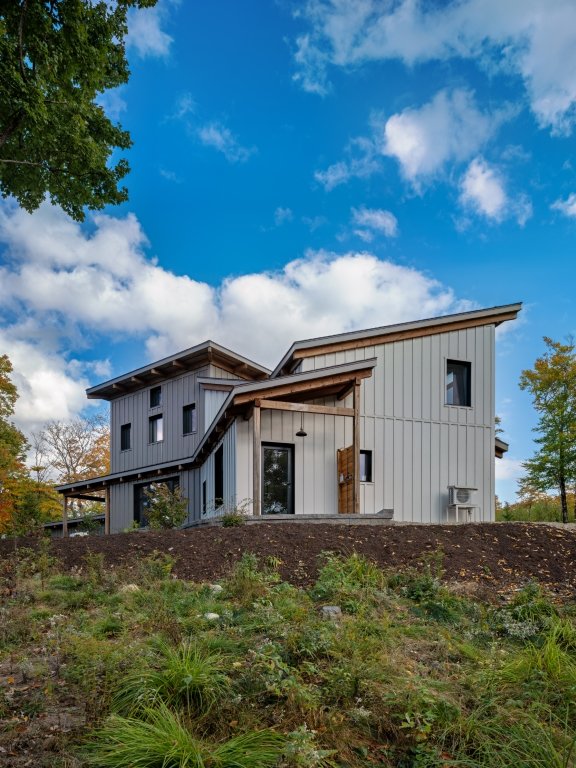Passive House rises in the mountains of Millinocket
A breathtaking outlook over Millinocket Lake and to the majestic mountains beyond.
Northern comfort
By June Donenfeld
Images: Dave Clough Photography
On a frosty February day in 2019, Meredith Randolph, architectural designer and building science expert, hiked through snowy woods to the summit of Hammond Ridge in Millinocket in northern Maine.
With her was Matt Polstein, owner of the New England Outdoor Center (NEOC) in Millinocket and longtime, staunch advocate for the Katahdin community and region. The ridge lies 1,100 feet above sea level, along the south shore of Millinocket Lake, and overlooks Katahdin, Maine’s highest mountain, to the north and the surrounding peaks. The view is breathtaking.
Small surprise, then, that this was the spot where Polstein envisioned building a high-performance home with his wife, wetland and soil scientist Johanna Szillery. The site they chose was a roughly two-and-half-acre parcel carved out of Polstein’s larger ownership of the 1,400 acres that compose the NEOC land.
The couple had goals for their home that were as lofty as the ground it would stand on.
Chief among them was a house that was in balance with its setting. “Natural beauty is what makes this place special, and I didn’t want to detract or distract from that,” Polstein says. He envisioned a home that would fit in with its natural surroundings. “I wanted expressly to avoid building a house that stood out on the landscape, whose size was out of scale for our needs and the setting.” In addition to space for the couple themselves, those needs included enough bedrooms to accommodate visiting family members as well as an attached garage.
The balance they sought also included the environmental impact of the home. “I wanted to produce and live in a house that was in balance from an energy standpoint and used no direct fossil fuels,” Polstein says.
To take full advantage of the southern sunrays, as well as the spectacular views over the lake and beyond to the mountains, the building’s orientation would be key to its success. “The house was designed around the view of Katahdin, which unfortunately for our Passive House goals, is to the north,” Randolph says. “It was challenging to design the house to maximize the southern solar gains but also maximize the occupants’ view of the mountain.”
The home's striking, angular form catches the eye, even as its earthy tones make it blend in with its surroundings.
Therein lay the design conundrum: how to make the northern outlook the star of the show and still have the house meet Passive House standards, which emphasize solar gain. Solar gain—the amount of heat that enters a building from sunlight passing through windows or doors—plays a key role in the overall energy efficiency and thermal performance of a building and usually entails large south-facing windows.
And then there was geography.
“Not only is this house in the very cold climate of northern Maine,” Randolph says, “but the elevation [of the site] had more impact than I was expecting on the energy modeling. That, along with the desired view being north, made it a fun challenge to achieve the Passive House standards of energy performance.”
Randolph relishes a good puzzle and knew an atypical design was in order. To focus on the northern vista while meeting Passive House standards, she took inspiration from an iconic utilitarian structure also found on ridgetops.
“The site evoked my love of fire towers,” she says, and so she placed a square room on the second level at a sharp angle to the rest of the roof. “While the house is oriented north-south, the square in the center—which references a fire tower—is rotated to look more directly at Katahdin, which is north but slightly off to the west.”
Her architectural answer to the challenges posed by the home’s location resulted in a series of striking exterior angles that intrigue but don’t intrude, thanks to the earthy tan and brown cladding and granite gray roof that enable the structure to blend in beautifully with its surroundings.
Randolph’s ingenious solution created a one-of-a-kind, 2,000-square-foot, 3- to 4-bedroom haven that is not only the northernmost Passive House in Maine but also enables its occupants to revel in the magnificent view from within the comfort of their own home. Polstein was thrilled with the design, delighted that “it was a Passive House with character, not a box.”
The visual interest of the home’s outside is matched by the configuration of spaces inside, which is a winning combination of the traditional and the unusual. “The house is a combination of open and cozy spaces,” Randolph says. The ground floor includes the primary suite, an open living room and kitchen area, a dining room with a den nook and an office off the mudroom. Upstairs, she created “multiple levels to enhance a sense of climbing up to the highest room in that center square.” With its four sides free from the rest of the roof, the “fire tower” feels open and airy and serves as both an entertainment room and an occasional bedroom; one step down is an adjacent bedroom with a “very cozy feel, being tucked under the roof line and down a step from the multipurpose room,” Randolph says.
From top to bottom, high-performance elements are everywhere. The super-insulated slab foundation bears an R-rating of 48, and the walls and roof are insulated with blown-in cellulose, with R-ratings of 55 and an average of 80, respectively, levels significantly above those required by Maine’s current building codes. Windows throughout are triple glazed, further enhancing the ability of the house to keep warm when it’s cold out—and cool in the summer months. Other than a high-efficiency, low-emissions rotating Hase Bari wood stove in the living/dining area for supplemental heat and coziness, the home is 100% electric, as are the homeowners’ vehicles. Two heat pumps provide cooling and heating, the oven is electric, the cooktop is induction and the clothes dryer is powered by a heat pump. Hot water is provided by a hybrid heat pump water heater, and an energy recovery ventilator (ERV) keeps the interior air fresh and clean. Solar panels produce more electricity than the house and the electric car use combined, making energy use net positive.
The living room features wood ceilings, pillars, and partially paneled walls; the modern staircase leads up to the multi-purpose "fire tower" and bedrooms.
A hands-on homeowner, Polstein threw himself into the project and helped with many aspects of the construction. “I did all the site and foundation prep for the slab,” he says, “including placing the insulated base. I also helped build the walls, apply the vapor barriers and air sealing, place the I-joist and trusses for the roof—and sealed the floors with a blend of citric acid and tung oil, a VOC-free natural finish. I even helped put on shingles!”
With the house complete, the area immediately around it is getting its fair share of attention, too. “A wild garden of local plants is in the making,” Polstein says, adding, “We’ve added some hardscape on the north side and have perennials in a bed of mulch growing there, too.”
Now that the couple has been living there for a while, Polstein has had time to reflect on his favorite aspects of the house—and there are many. “It’s very quiet, it sips energy, and it stays a very uniform temperature unless you work to change it,” he says. “I love the fact that the balance between our energy use and eight-kilowatt solar array is such that it not only powers our house but has energy to spare to support the charging of our electric vehicles.”
The high levels of insulation have brought peace of mind, too. “It’s nice to know that in the middle of the winter, if the power goes out and the generator doesn’t come on, you’ve got days before your house cools off,” he says.
And his advice for anyone considering building a Passive House? “Do it. The quality of the home and the savings on energy, not to mention the benefits to the earth, are well worth any marginal cost increase.”
A letter Polstein sent to Randolph in the dead of winter shows just how content the couple is with their new home:
“As I write, it’s one below zero here, the wind has been howling, and it’s with humor that I tell you that we’ve yet to turn on the heat pumps for heat. I’m amazed daily at how uniform the temperature in the house is; the [woodstove] is perfect, as it is a mix of convective and radiant heat and seems to distribute heat incredibly well around the house. Yesterday after a week of gray and cloudy skies, the sun shone brightly, and we immediately saw a five- or six-degree temperature increase from our south-facing windows, thus the warm temperature last evening. Passive House living is not disappointing us!”
Project Team
Design: Meredith Randolph, Four Winds Design
Builder: R. R. Builders
Plumbing and Heating: J.H. McPartland & Sons
PHIUS Rater: Michael Browne, Advanced Building Analysis
This article appeared in the Winter 2024 edition of Green & Healthy Maine. Subscribe today!
Find Maine experts that specialize in healthy, efficient homes in the Green Homes Business Directory.









